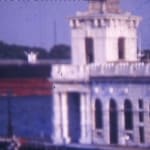Nicolás García Uriburu
Coloration of Venice, 1968
Super 8
various footage, 06:56 min, and 33:40 min
Further images
Influenced perhaps by his background in architecture, Uriburu’s colorations invert the canonical romanticism of the western genre of landscape painting into a romanticization of the metropolis. As said by Laura...
Influenced perhaps by his background in architecture, Uriburu’s colorations invert the canonical romanticism of the western genre of landscape painting into a romanticization of the metropolis. As said by Laura Batkis, “Faced with the apocalyptic prophecy of ecological disaster, Uriburu acts as a contemporary demiurge, evoking imaginary rituals of integrationist agreements that recall the primal communion of man with nature.”
On June 19, 1968, he made a transgressive gesture by dyeing the waters of Venice’s Grand Canal green using Fluorescein, an organic and ecologically harmless dye developed by NASA, which is also utilized as a diagnostic contrast agent with various practical applications, such as astronautics, ophthalmology, and plumbing. Fluorescein is blood red in its powdered state, but it turns green when it comes into contact with water. This action was not part of the official program of the 34th Venice Biennale, but rather an intervention, timed to coincide with the opening as well as the time of day in which the tides were at their peak.
Assisted by Memo, a gondolier and amateur painter, Uriburu carried out the action at 8 am, the moment of the most favorable high tide, when the waters of the lagoon spread into all the canals. Blanca, his wife, and Pierre Restany, his friend and French art critic, documented the action. Uriburu’s intervention dramatically altered the Venetian landscape for eight hours, with the two-mile and nine-foot-deep canal’s waters glowing green until the dye gradually dissipated with the low tide. The action was calculated to highlight the connection between nature and civilization and to emphasize the importance of ecological awareness in culture. The depth, the currents, and the ebbing tide of the Grand Canal in Venice served as materials for this artwork.
On June 19, 1968, he made a transgressive gesture by dyeing the waters of Venice’s Grand Canal green using Fluorescein, an organic and ecologically harmless dye developed by NASA, which is also utilized as a diagnostic contrast agent with various practical applications, such as astronautics, ophthalmology, and plumbing. Fluorescein is blood red in its powdered state, but it turns green when it comes into contact with water. This action was not part of the official program of the 34th Venice Biennale, but rather an intervention, timed to coincide with the opening as well as the time of day in which the tides were at their peak.
Assisted by Memo, a gondolier and amateur painter, Uriburu carried out the action at 8 am, the moment of the most favorable high tide, when the waters of the lagoon spread into all the canals. Blanca, his wife, and Pierre Restany, his friend and French art critic, documented the action. Uriburu’s intervention dramatically altered the Venetian landscape for eight hours, with the two-mile and nine-foot-deep canal’s waters glowing green until the dye gradually dissipated with the low tide. The action was calculated to highlight the connection between nature and civilization and to emphasize the importance of ecological awareness in culture. The depth, the currents, and the ebbing tide of the Grand Canal in Venice served as materials for this artwork.






